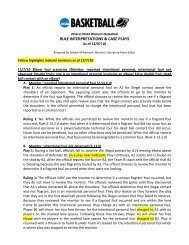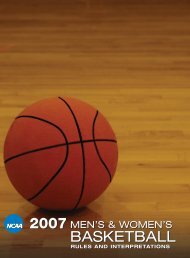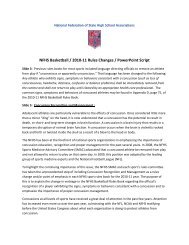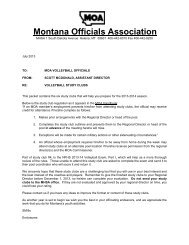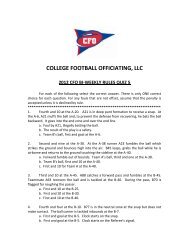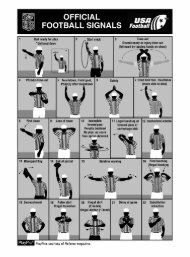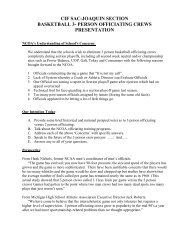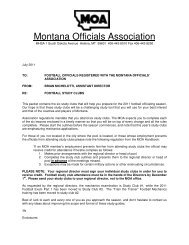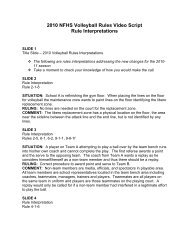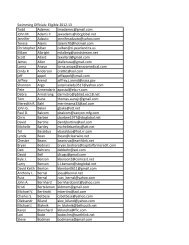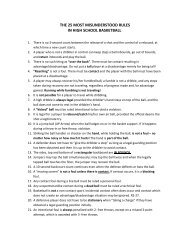MONTANA OFFICIALS ASSOCIATION - MOA - ArbiterSports
MONTANA OFFICIALS ASSOCIATION - MOA - ArbiterSports
MONTANA OFFICIALS ASSOCIATION - MOA - ArbiterSports
Create successful ePaper yourself
Turn your PDF publications into a flip-book with our unique Google optimized e-Paper software.
2. Contact above the shoulders. With a continued emphasis on reducing concussions and<br />
decreasing excessive contact situations, the committee determined that more guidance is needed<br />
for penalizing contact above the shoulders.<br />
a. A player shall not swing his/her arm(s) or elbow(s) even without contacting an<br />
opponent. Excessive swinging of the elbows occurs when arms and elbows are swung<br />
about while using the shoulders as pivots, and the speed of the extended arms and<br />
elbows is in excess of the rest of the body as it rotates on the hips or on the pivot foot.<br />
Currently it is a violation in Rule 9 Section 13 Article.<br />
b. Examples of illegal contact above the shoulders and resulting penalties.<br />
1) Contact with a stationary elbow may be incidental or a common foul.<br />
2) An elbow in movement but not excessive should be an intentional foul.<br />
3) A moving elbow that is excessive can be either an intentional foul or flagrant<br />
personal foul.<br />
3. Intentional Fouls. The committee is concerned about the lack of enforcement for intentional<br />
fouls during any part of the game but especially at the end of a game. The intentional foul rule<br />
has devolved into misapplication and personal interpretations. An intentional foul is a personal or<br />
technical foul that neutralizes an opponent’s obvious advantageous position. Contact away from<br />
the ball or when not making a legitimate attempt to play the ball, specifically designed to stop or<br />
keep the clock from starting, shall be intentional. Intentional fouls may or may not be<br />
premeditated and are not based solely on the severity of the act. A foul also shall be ruled<br />
intentional if while playing the ball a player causes excessive contact with an opponent.<br />
a. Anytime during the game. Acts that neutralize an opponent’s obvious advantageous<br />
position and must be deemed intentional include:<br />
1) Excessive contact on any player attempting a try<br />
2) Grabbing or shoving a player from behind when an easy basket may be scored<br />
3) Grabbing and holding a player from behind or away from the ball<br />
These are “non-basketball acts” and must be considered intentional fouls<br />
b. Game awareness. The probability of fouling late in the game is an accepted coaching<br />
strategy and is utilized by many coaches in some form. Officials must have the courage<br />
to enforce the intentional foul rule properly.<br />
4. Guidelines to enforce illegal contact. Escalating fight situations can often be traced back to<br />
illegal contact not being properly enforced and penalized.<br />
Examples of illegal contact are:<br />
a. Hand checking. Any tactic using hands or arms that allows a player on offense or<br />
defense to control the movement of an opposing player.<br />
Examples of hand checking foul.<br />
1) Both hands on an opposing player<br />
2) Jabbing a hand or forearm on an opponent.<br />
3) Continuous contact by a hand or forearm on an opponent<br />
b. Post play. Any tactic using hands, arms or body to control the movement of an<br />
opposing player.<br />
Examples of illegal post play.<br />
1) Hooking by the offensive player<br />
2) Pushing, holding or slapping an opponent<br />
3) Dislodging an opponent by using a leg or knee to the rear of an opponent<br />
4) Dislodging an opponent by backing them down<br />
c. Rebounding. Any activity to illegally gain rebounding position on an opponent.<br />
Examples of illegal rebounding activity.<br />
1) Displacing, charging or pushing an opponent<br />
2) Extending the arms or elbows to impede the movement of an opponent<br />
3) Using the hips or knees to hinder or impede an opponent<br />
4) Violation of the principle of verticality<br />
5) Contact between players in free-throw lane spaces prior to the ball contacting the<br />
ring<br />
d. It is illegal to physically contact an opponent prior to the ball legally contacting the ring.




